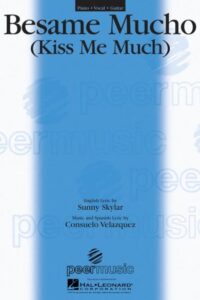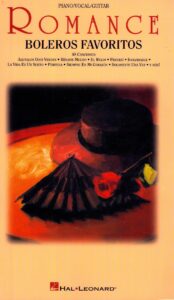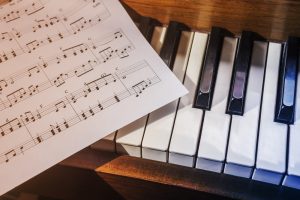Table of Contents
Bésame Mucho (Bolero by Consuelo Velázquez) Piano Sheet Music, Partitura, Noten, spartiti, partition 楽譜
Come join us now, and enjoy playing your beloved music and browse through great scores of every level and styles!
Can’t find the songbook you’re looking for? Please, email us at: sheetmusiclibrarypdf@gmail.com We’d like to help you!

Best Sheet Music download from our Library.

Please, subscribe to our Library.
If you are already a subscriber, please, check our NEW SCORES’ page every month for new sheet music. THANK YOU!
“Bésame Mucho” is one of the most famous and enduring boleros in Latin music history. Composed by Consuelo Velázquez in 1941, the song has become a timeless classic, covered by countless artists across various genres and languages. Below is a detailed breakdown of its history, musical characteristics, and notable versions.

1. Author: Consuelo Velázquez
- Full Name: Consuelo Velázquez Torres (1916–2005)
- Nationality: Mexican
- Background: A classically trained pianist, Velázquez wrote “Bésame Mucho” when she was just 25 years old (though some sources claim she was even younger). Despite having never been kissed at the time, she composed this passionate love song inspired by Enrique Granados’ piano piece “Goyescas”, particularly the movement “Quejas, o La Maja y el Ruiseñor” (“Lament, or The Maiden and the Nightingale”).
- Other Works: She also wrote other boleros like “Amar y vivir” and “Cachito”, but none matched the success of “Bésame Mucho”.
2. Musical Style & Structure
- Genre: Bolero (slow-tempo Latin love song with romantic lyrics)
- Time Signature: 4/4
- Key: Typically performed in D minor (though transposed in different versions).
- Harmony:
- Features a descending chromatic bassline (common in boleros).
- The chord progression includes Dm – Gm – A7 – Dm (with variations).
- The melody is lyrical and expressive, with a dramatic, yearning quality.
- Lyrics: The song is about passionate, almost desperate love, pleading for kisses (“Bésame, bésame mucho” – “Kiss me, kiss me a lot”) as if each one could be the last.
3. Historical Context & Influence
- Inspiration: As mentioned, Velázquez drew from Granados’ classical piece, adapting its melancholic beauty into a popular song.
- Early Popularity:
- First recorded in 1941 by Emilio Tuero (Mexican singer).
- Gained international fame when Andy Russell recorded it in 1944, making it a hit in the U.S.
- Global Reach: The song became a WWII-era favorite, as soldiers embraced its romantic longing. It was later translated into multiple languages (English, Italian, French, etc.).
4. Famous Versions & Covers
Over 1,000+ recordings exist. Here are some of the most iconic:
A) Early & Classic Versions
- Emilio Tuero (1941) – The first recorded version (in Spanish).
- Andy Russell (1944) – Popularized it in the U.S.
- Pedro Infante (1950s) – A beloved Mexican interpretation.
- The Beatles (1962) – Performed it live at the Cavern Club (a rare non-rock cover by the band).
- Nat King Cole (1960s) – His smooth, English-Spanish version remains definitive.
B) Jazz & Instrumental Versions
- Charlie Parker (1940s) – A bebop adaptation.
- Dave Brubeck (1960s) – Jazz piano rendition.
- Stan Getz (1980s) – Bossa nova-infused version.
C) Pop & Modern Covers
- Luis Miguel (1990s) – A lush, orchestral take.
- Andrea Bocelli (2006) – Operatic interpretation.
- Cesária Évora (2009) – Cape Verdean morna-style version.
D) Unusual & Unexpected Covers
- The Coasters (1958) – Doo-wop version.
- Xavier Cugat (1940s) – Rumba arrangement.
- Plácido Domingo (1980s) – Classical crossover.
5. Legacy & Cultural Impact
- One of the most recorded Spanish-language songs ever (alongside “Guantanamera” and “El Manisero”).
- Featured in films like “The Big Lebowski” (1998) and “Moonlight” (2016).
- UNESCO recognized it as part of the world’s musical heritage.
- Still a wedding/love song staple in Latin America and beyond.
“Bésame Mucho” is a masterpiece of romantic longing, blending classical influences with the emotional depth of the bolero. Its haunting melody and universal theme ensure its immortality in global music. Whether heard in a jazz club, a mariachi performance, or a pop cover, it remains the ultimate kiss-themed song.
Browse in the Library:
Or browse in the categories menus & download the Library Catalog PDF:
Did The Beatles performed a version of the song Bésame Mucho?
YES! The Beatles’ version of “Bésame Mucho”—recorded in their early Cavern Club days (1962) and later at their Decca audition—is a fascinating departure from Consuelo Velázquez’s original. While staying true to the song’s romantic core, they infused it with their rock & roll energy and subtle harmonic twists. Here’s a breakdown of the key differences:
1. Key & Tempo
- Original (Consuelo Velázquez/Emilio Tuero, 1941)
- Key: D minor (classic bolero tonality)
- Tempo: Slow, rubato (free, expressive pacing)
- The Beatles’ Version (1962)
- Key: E minor (transposed up a whole step for a brighter, edgier sound)
- Tempo: Faster, with a rockabilly shuffle (closer to Little Richard’s style than a traditional bolero)
2. Harmonic Variations
A) Chord Progressions
- Original:
- Intro/Verse: Dm → Gm → A7 → Dm (standard bolero descending bassline)
- Uses chromatic passing chords (e.g., Dm → Dm/C → Bb7 → A7) for dramatic tension.
- The Beatles’ Version:
- Simplifies some changes but adds rock & roll substitutions:
- Replaces the Gm with G7 (bar 3) for a bluesier feel.
- Uses E7 → A7 instead of a straight A7 (adding a secondary dominant).
- Occasionally inserts C → B7 (borrowed from E harmonic minor) for a raw, garage-rock edge.
B) Instrumentation & Texture
- Original: Orchestral or piano-based, with lush strings and romantic phrasing.
- The Beatles:
- Paul’s bassline is more active (walking bass in parts).
- George’s guitar adds Chuck Berry-esque licks between verses.
- John’s rhythm guitar uses choppy, percussive chords (like in “Money”).
- Pete Best’s drums drive a backbeat (unheard in traditional boleros).
3. Structural Tweaks
- Original:
- Traditional A-A-B-A form with a dramatic, elongated bridge (“Es como un sueño…“).
- The Beatles:
- Cuts the bridge short (likely for live performance brevity).
- Repeats the chorus with call-and-response vocals (John and Paul harmonizing).
- Ends abruptly with a rock & roll stop-time (no lingering fade-out).
4. Why These Changes?
- Context: The Beatles were a cover band in 1962, heavily influenced by Little Richard, Elvis, and Latin-tinged rock (e.g., “Twist and Shout”). Their version reflects their:
- Energy: Faster tempo = danceable for Liverpool crowds.
- Limited Spanish: Pronunciation is rough (e.g., “Besame moocho“), so they leaned into attitude over authenticity.
- Harmonic Rebellion: Even in covers, they tweaked chords to sound “tougher” (e.g., adding 7ths).
5. Listen for Yourself
- Original (Emilio Tuero, 1941): YouTube Link
- The Beatles (1962 Decca Audition): YouTube Link
The Beatles’ “Bésame Mucho” is a rockified time capsule—less about bolero melancholy and more about the raw energy of their Hamburg days. Yet, it oddly works because they kept the song’s emotional core (Paul’s vocal delivery is surprisingly tender).
Fun fact: This was one of the few Spanish-language songs they ever performed!
